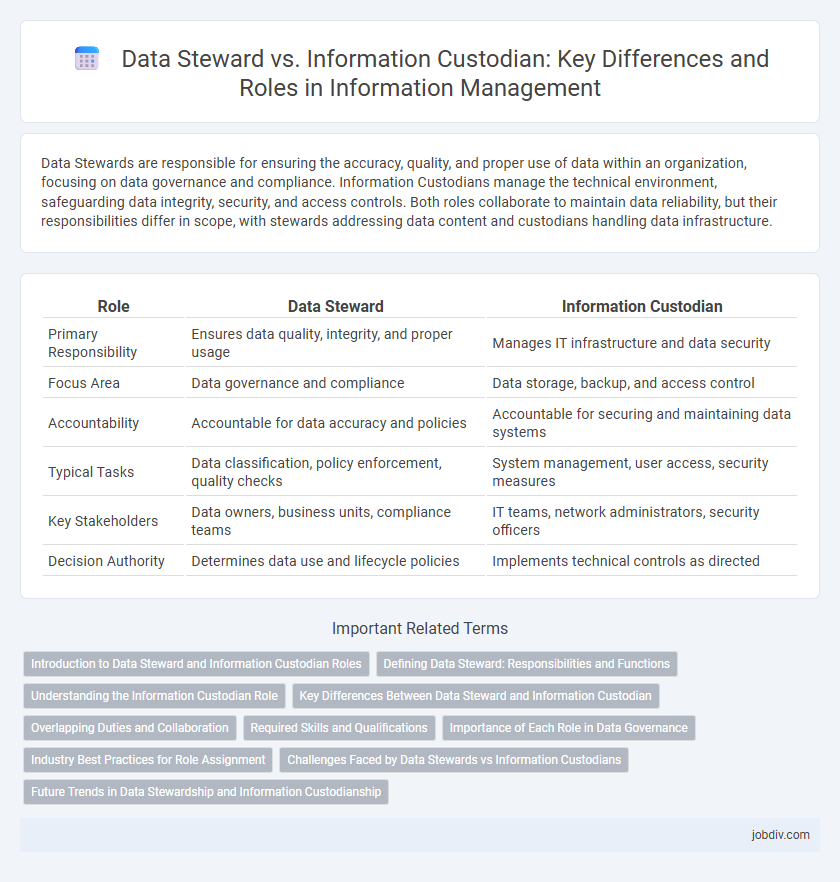Data Stewards are responsible for ensuring the accuracy, quality, and proper use of data within an organization, focusing on data governance and compliance. Information Custodians manage the technical environment, safeguarding data integrity, security, and access controls. Both roles collaborate to maintain data reliability, but their responsibilities differ in scope, with stewards addressing data content and custodians handling data infrastructure.
Table of Comparison
| Role | Data Steward | Information Custodian |
|---|---|---|
| Primary Responsibility | Ensures data quality, integrity, and proper usage | Manages IT infrastructure and data security |
| Focus Area | Data governance and compliance | Data storage, backup, and access control |
| Accountability | Accountable for data accuracy and policies | Accountable for securing and maintaining data systems |
| Typical Tasks | Data classification, policy enforcement, quality checks | System management, user access, security measures |
| Key Stakeholders | Data owners, business units, compliance teams | IT teams, network administrators, security officers |
| Decision Authority | Determines data use and lifecycle policies | Implements technical controls as directed |
Introduction to Data Steward and Information Custodian Roles
Data Stewards are responsible for managing data quality, ensuring accuracy, and enforcing data governance policies within an organization. Information Custodians focus on the technical management and safeguarding of data, including storage, access controls, and security protocols. Both roles collaborate to maintain data integrity and compliance, with stewards overseeing data usage and custodians handling the infrastructure that protects information assets.
Defining Data Steward: Responsibilities and Functions
Data Steward is responsible for managing data quality, ensuring accuracy, integrity, and compliance with organizational policies throughout the data lifecycle. They define and enforce data standards, oversee data usage, and facilitate collaboration between business and IT teams to optimize data assets. Their functions include data classification, access control coordination, and monitoring data stewardship practices to maintain data reliability and usability.
Understanding the Information Custodian Role
The Information Custodian role involves managing and protecting data access, ensuring security protocols are followed, and maintaining data integrity within IT systems. Unlike Data Stewards who oversee data quality and compliance at the business level, Information Custodians are responsible for the technical environment where the data resides. They implement access controls, monitor system usage, and support data owners in enforcing organizational policies.
Key Differences Between Data Steward and Information Custodian
Data Stewards focus on the accuracy, integrity, and quality of data, ensuring it meets organizational standards and compliance requirements. Information Custodians manage the technical environment and security controls that protect data from unauthorized access and ensure data availability. The key difference lies in Data Stewards handling data content and governance, while Information Custodians are responsible for data infrastructure and operational security.
Overlapping Duties and Collaboration
Data Stewards and Information Custodians share overlapping duties in managing data quality, ensuring compliance with policies, and safeguarding sensitive information within an organization. Collaboration between these roles is crucial for aligning data governance processes, as Data Stewards typically focus on data usage and integrity while Information Custodians handle the technical management and security of data systems. Effective communication and coordinated efforts improve data accuracy, accessibility, and risk mitigation across the data lifecycle.
Required Skills and Qualifications
Data Stewards require strong expertise in data governance, data quality management, and regulatory compliance, typically holding certifications like CDMP or DAMA. Information Custodians need technical skills in IT infrastructure, access controls, and cybersecurity, often possessing certifications such as CISSP or CompTIA Security+. Both roles demand proficiency in data privacy laws and organizational policies, ensuring secure and compliant information handling.
Importance of Each Role in Data Governance
Data stewards play a critical role in data governance by ensuring data quality, accuracy, and compliance with organizational policies, acting as the primary custodians of data content and context. Information custodians focus on the security and technical management of data, maintaining access controls, backups, and system integrity to protect data assets from unauthorized use or breaches. The collaboration between data stewards and information custodians is essential for maintaining a comprehensive data governance framework that balances data usability with rigorous security standards.
Industry Best Practices for Role Assignment
Data Stewards are responsible for ensuring data quality, accuracy, and compliance by defining data standards and policies, while Information Custodians manage the technical environment where data resides, focusing on data security, storage, and access controls. Industry best practices recommend assigning Data Steeward roles to business units for domain expertise, whereas Information Custodian roles are allocated to IT departments for infrastructure management. Clear role delineation improves accountability, data governance maturity, and aligns responsibilities with organizational workflows.
Challenges Faced by Data Stewards vs Information Custodians
Data Stewards face challenges such as ensuring data accuracy, maintaining data quality standards, and managing compliance with regulatory requirements, which demand a deep understanding of data governance policies. Information Custodians primarily struggle with safeguarding data security, implementing access controls, and ensuring the availability of information systems to prevent unauthorized data breaches. Both roles require balancing operational responsibilities with organizational policies, but Data Stewards focus more on data integrity while Information Custodians emphasize data protection and infrastructure reliability.
Future Trends in Data Stewardship and Information Custodianship
Future trends in data stewardship emphasize automated governance tools powered by AI to enhance data quality and compliance. Information custodianship is evolving with increased focus on cybersecurity frameworks and real-time monitoring to protect sensitive data assets. Both roles are converging towards integrated platforms that prioritize data privacy, ethical management, and regulatory adherence.
Data Steward vs Information Custodian Infographic

 jobdiv.com
jobdiv.com